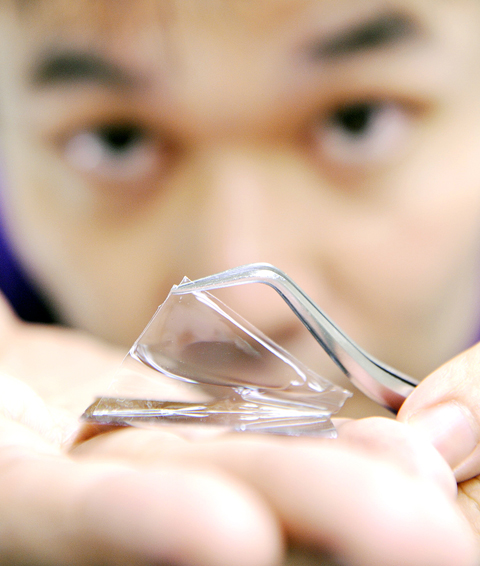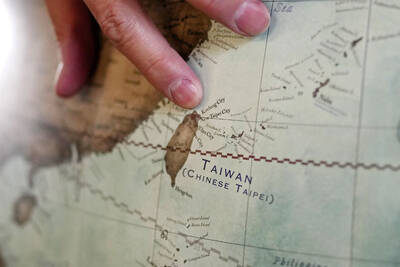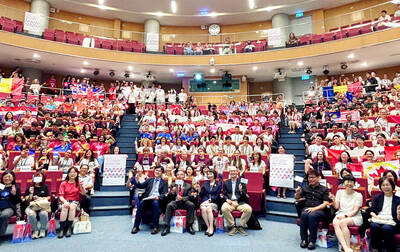The Internet has changed many things, of course, but one of its more far-reaching effects has been to transform the economics of innovation.
Big corporate research and development laboratories — at IBM, General Electric (GE), Hewlett-Packard and a handful of other companies — have their roots and rationale in the industrial era, when communication was costly, information traveled slowly and social networks were fostered at conferences and lunchrooms instead of over the Web.
Crowdsourcing and other new, more open models of innovation are really byproducts of the low-cost communication and new networks of collaboration made possible by the Internet.

PHOTO: AFP
So, in the Internet era, what is the continuing role and comparative advantage of the corporate research and development (R&D) lab?
Its role will be smaller and its advantage diminished, said Michael Schrage, a research fellow at the Center for Digital Business at the Sloan School of Management at the Massachusetts Institute of Technology (MIT). The idea-production process, Schrage said, will continue to shift away from the centralized model epitomized by large corporate labs, going from “proprietary innovation to populist innovation.”
Much of traditional corporate R&D spending, he said, has been subsidized by profits that are increasingly under Internet-era pressures.
“The economic case for a lot of in-house R&D no longer makes sense,” Schrage said.
The best bet for corporate R&D labs, he said, is to adopt a “federated” model that leverages all the innovative work by outsiders in universities, start-ups, business partners and government labs. The corporate lab’s role, then, is to be more of a coordinator and integrator of innovation, from both outside and inside the company walls.
Though hardly alone, Hewlett-Packard has aggressively adopted that approach in the last two years, after Prith Banerjee became the senior vice president for research. Under Banerjee, former dean of engineering at the University of Illinois at Chicago, HP Labs has not only narrowed its focus, placing larger bets on fewer projects, but has also systematically sought outside ideas.
HP now runs a yearly online contest, soliciting grant proposals from universities worldwide. The company lists eight fields in which it is seeking advanced research, and scientists suggest research projects in those fields.
The HP grants are typically about US$75,000 a year, and many of the collaborative projects are intended to last three years. In June, the company announced the 61 winners from 46 universities and 12 countries, including 31 projects receiving a second year of funding.
“We are tapping the collective intelligence, selectively, of leading academics around the world,” Banerjee said.
Alan Willner, an electrical engineer at the University of Southern California, is one of those academics. He is an expert in photonics, using light photons instead of electrons to transmit information. The goal of the project with HP is to cut power consumption and increase data-transmission speeds between computers in data centers, and eventually even inside of chips.
The HP project, he said, supports a research student, provides insights from HP scientists and has helped double the productivity of his research team, whose members have co-authored 21 conference and journal papers related to the project in the last year.
Another name on all those papers is Raymond Beausoleil, an HP research fellow. The USC team, Beausoleil said, has helped fill a gap in photonics expertise in the company’s research program and accelerated its progress. He said that HP Labs has long worked with university professors, but that the outreach tended to be informal and ad hoc.
“Before,” he said, “there wasn’t necessarily a mandate to collaborate.”
Opening up is a good approach to some problems. But tight-knit teams inside corporate labs, experts say, can outshine the open model when working on multidisciplinary challenges in projects soon heading to market.
GE built up a biosciences unit, starting in 2004, to help push its diagnostic imaging technology to new commercial frontiers. Last year, GE and the University of Pittsburgh Medical Center developed a prototype scanner that sharply cuts the time needed to digitize images on pathology slides.
Now, the GE researchers are working on the software and data analysis tools to look into such images for a deeper understanding of diseases. GE is collaborating with Eli Lilly and the Memorial Sloan-Kettering Cancer Center. But the core is a 15-person team at GE Research that includes computer scientists, molecular biologists, chemists and statisticians.
“It really helps to have the close and constant communications loops within the team, because engineers have to learn a lot of biology and biologists have to learn a lot of engineering,” said Fiona Ginty, a bioinformatics scientist who leads the project.
Probably more than any other company, IBM has successfully reinvented its R&D labs over the years, analysts say. Jolted by its early-1990s tailspin, IBM opened its labs to the outside world and to customers. Since the mid-1990s, it has sharply shifted its research focus toward its growth engines of software and services.
IBM is a major underwriter of open research in universities, but also collects more patents for its own use than any other company, year after year.
The open innovation model, said John Kelly, senior vice president and director of research, has many advantages. But he points to several innovations that became products after originating in IBM labs.
“You can’t leave discovery completely to others and to chance,” he said.

TAIWAN IS TAIWAN: US Representative Tom Tiffany said the amendment was not controversial, as ‘Taiwan is not — nor has it ever been — part of Communist China’ The US House of Representatives on Friday passed an amendment banning the US Department of Defense from creating, buying or displaying any map that shows Taiwan as part of the People’s Republic of China (PRC). The “Honest Maps” amendment was approved in a voice vote on Friday as part of the Department of Defense Appropriations Act for the 2026 fiscal year. The amendment prohibits using any funds from the act to create, buy or display maps that show Taiwan, Kinmen, Matsu, Penghu, Wuciou (烏坵), Green Island (綠島) or Orchid Island (Lanyu, 蘭嶼) as part of the PRC. The act includes US$831.5 billion in

‘WORLD WAR III’: Republican Representative Marjorie Taylor Greene said the aid would inflame tensions, but her amendment was rejected 421 votes against six The US House of Representatives on Friday passed the Department of Defense Appropriations Act for fiscal 2026, which includes US$500 million for Taiwan. The bill, which totals US$831.5 billion in discretionary spending, passed in a 221-209 vote. According to the bill, the funds for Taiwan would be administered by the US Defense Security Cooperation Agency and would remain available through Sept. 30, 2027, for the Taiwan Security Cooperation Initiative. The legislation authorizes the US Secretary of Defense, with the agreement of the US Secretary of State, to use the funds to assist Taiwan in procuring defense articles and services, and military training. Republican Representative

Taiwan is hosting the International Linguistics Olympiad (IOL) for the first time, welcoming more than 400 young linguists from 43 nations to National Taiwan University (NTU). Deputy Minister of Education Chu Chun-chang (朱俊彰) said at the opening ceremony yesterday that language passes down knowledge and culture, and influences the way humankind thinks and understands the world. Taiwan is a multicultural and multilingual nation, with Mandarin Chinese, Taiwanese, Hakka, 16 indigenous languages and Taiwan Sign Language all used, Chu said. In addition, Taiwan promotes multilingual education, emphasizes the cultural significance of languages and supports the international mother language movement, he said. Taiwan has long participated

The paramount chief of a volcanic island in Vanuatu yesterday said that he was “very impressed” by a UN court’s declaration that countries must tackle climate change. Vanuatu spearheaded the legal case at the International Court of Justice in The Hague, Netherlands, which on Wednesday ruled that countries have a duty to protect against the threat of a warming planet. “I’m very impressed,” George Bumseng, the top chief of the Pacific archipelago’s island of Ambrym, told reporters in the capital, Port Vila. “We have been waiting for this decision for a long time because we have been victims of this climate change for